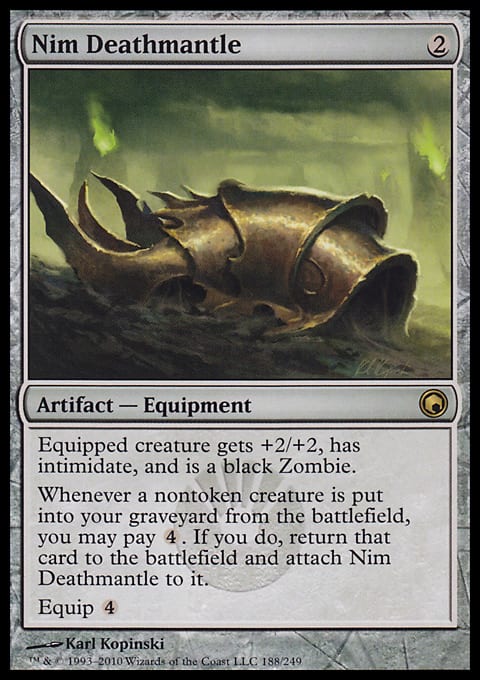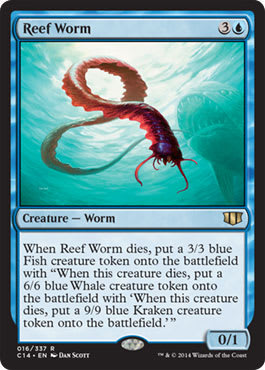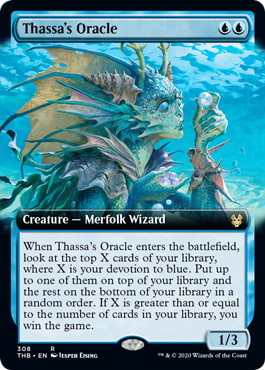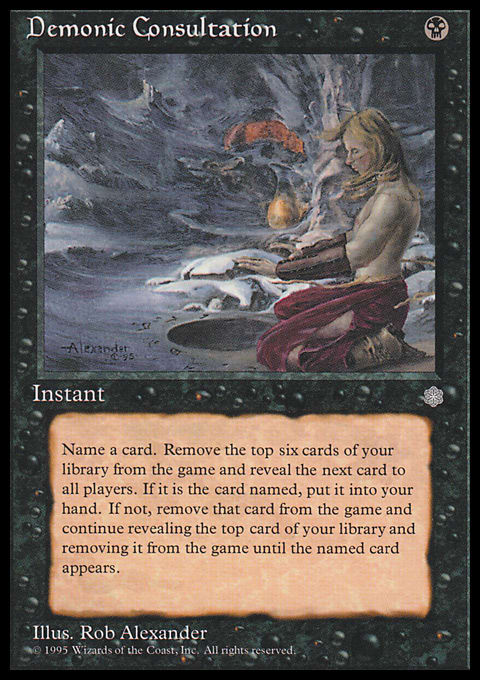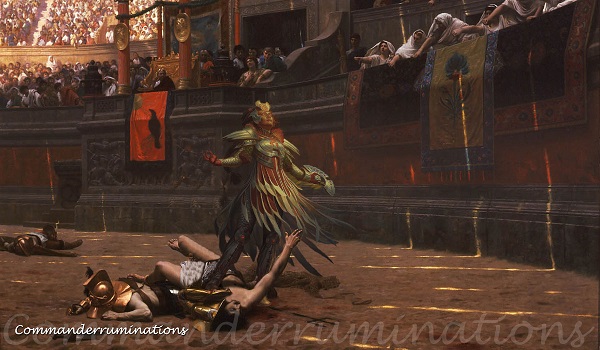
Pollice Verso by Jean-Leon Gerome (1872). Huatli, Radiant Champion by Chris Rahn.
About a month ago, Jason Alt wrote a 75% focused column about Kels, Fight Fixer. You can (and should) read it. At the time I was torn between building and writing about Kels, Fight Fixer, Muxus, Goblin Grandee and Neyith of the Dire Hunt. I pulled all three from Jumpstart boosters and I like to build and write about decks I'm actually going to build in paper. When I saw that Jason called "dibs" on Kels I turned my attention to my other options, but I couldn't get Kels out of my head.
I had just pulled Nim Deathmantle out of my Grumgully, the Generous persist combo deck because I was just never hitting it in games. The deck is a powerhouse and I want to tune it up for cEDH play. Part of that process is pulling out cards that aren't helping and my Siege-Gang Commander and Nim Deathmantle combo were really just taking up space. Pulling that out of Grumgully made it available for another deck and I decided I really wanted to build a dedicated Nim Deathmantle combo deck.
Kels might not be the best choice in history for Nim Deathmantle, but it sure isn't a bad one. Kels has card draw in her text box, she's in black so we can run great tutors and we're in blue so we can protect the win.
I decided I wanted to not only see if I could build a Kels Nim Deathmantle combo deck - I decided I wanted to see if I could build a cEDH Kels Nim Deathmantle combo deck! Any semi-competitive build I threw together wouldn't have enough distance between it and Jason Alt's list to warrant writing it up for Commanderruminations so recently after Jason's piece went up.
I know a few things about competitive Commander, but I'm far from a cEDH guru. I can occasionally throw together what I think of as a "fringe" cEDH list but for this project I decided to reach out to a friend for some help. I worked with Bryan Li, local judge, Commander player and cEDH aficionado, back in 2018 to put together a column about his Tasigur, the Golden Fang deck. He's been helping local players tune up their lists for years and was happy to help me out.
The Starting Point
I worked up a paper version of Kels Deathmantle combo and played it a few times at my LGS recently. It didn't have the fast mana or a lot of the initial tune-ups the deck needed, but I was able to combo off in one of the games. I knew the deck would have the ability to win games, but it was nice to play an even more casual version than I was going to put together and see it "get there" before doing my initial improvements.
I should take a moment to go over the key combo that is driving this project.
You have a sacrifice outlet; Ashnod's Altar is the best option, but Phyrexian Altar can also make mana to help fuel the loop. You have Nim Deathmantle, which for four mana can attach to a creature put into your graveyard from the battlefield and bring it back. Then you have a creature like the Reef Worm that can create additional creatures. In my Grumgully deck Siege-Gang Commander and a few other Goblins filled this role. In this list there are a number of options, including Sling-Gant Lieutenant, Weaponcraft Enthusiast and others.
The best of the lot might be Priest of Gix, as it gives you three Black mana when it comes into play. Going infinite and making mana is fine, but you need colored mana to pay into Kels' card draw ability. You'll also be able to sac her to her own ability and re-cast her to draw your whole deck, but that won't work if you're only making colorless mana.
To win, you set up an infinite loop and then use one of a number of payoff cards like Blood Artist or Zulaport Cutthroat to kill your opponents.
My next step was to tune this up with a mind to making it competitive. That meant theorycrafting a list. I was throwing budget out the window, but my instincts still held me back. I'm just not used to adding a Mox or an Imperial Seal to a deck even though I'm aware that they are better cards. My habit of building in paper leaves me with blind spots for cards I don't own. My casual tendencies result in lists like the one below, which could surely win games, but might not be quite good enough to be a true cEDH deck.
Kels, Fight Fixer Deathmantle Combo | Commander | Stephen Johnson
- Commander (1)
- 1 Kels, Fight Fixer
- Creatures (26)
- 1 Blood Artist
- 1 Bog Initiate
- 1 Carrier Thrall
- 1 Carrion Feeder
- 1 Dimir Infiltrator
- 1 Discordant Piper
- 1 Doomed Dissenter
- 1 Falkenrath Noble
- 1 Grim Haruspex
- 1 Mulldrifter
- 1 Orzhov Enforcer
- 1 Pawn of Ulamog
- 1 Pitiless Plunderer
- 1 Priest of Gix
- 1 Reef Worm
- 1 Sadistic Hypnotist
- 1 Shriekmaw
- 1 Sidisi, Undead Vizier
- 1 Syr Konrad, the Grim
- 1 Sling-Gang Lieutenant
- 1 Smothering Abomination
- 1 Tribute Mage
- 1 Trophy Mage
- 1 Viscera Seer
- 1 Weaponcraft Enthusiast
- 1 Zulaport Cutthroat
- Instants (16)
- 1 Ad Nauseam
- 1 Arcane Denial
- 1 Counterspell
- 1 Cyclonic Rift
- 1 Dramatic Reversal
- 1 Fierce Guardianship
- 1 Flusterstorm
- 1 Force of Will
- 1 Muddle the Mixture
- 1 Pact of Negation
- 1 Perplex
- 1 Pongify
- 1 Rapid Hybridization
- 1 Shred Memory
- 1 Tragic Slip
- 1 Vampiric Tutor
- Sorceries (6)
- 1 Demonic Tutor
- 1 Diabolic Intent
- 1 Dimir Machinations
- 1 Dread Return
- 1 Grim Tutor
- 1 Spark Harvest
- Enchantments (3)
- 1 Bastion of Remembrance
- 1 Black Market
- 1 Grave Pact
- Artifacts (13)
- 1 Arcane Signet
- 1 Ashnod's Altar
- 1 Bolas's Citadel
- 1 Dimir Signet
- 1 Fellwar Stone
- 1 Isochron Scepter
- 1 Mana Crypt
- 1 Mana Vault
- 1 Mind Stone
- 1 Nim Deathmantle
- 1 Phyrexian Altar
- 1 Skullclamp
- 1 Sol Ring
- Lands (35)
- 13 Island
- 13 Swamp
- 1 Buried Ruin
- 1 Command Tower
- 1 Drowned Catacomb
- 1 Exotic Orchard
- 1 Morphic Pool
- 1 Sunken Hollow
- 1 Sunken Ruins
- 1 Underground Sea
- 1 Watery Grave
You can tell this isn't a true cEDH deck pretty easily - just look at all those creatures!
I mean, it looks like a cEDH list, but if you know what you're looking for you'll know that it's pretty far from the top of our format's power spectrum.
This deck weighs in with an average CMC of 2.65, which is amazing for me, but that probably isn't going to impress anyone with a lot of experience in cEDH. Low CMC doesn't necessarily mean a deck is high-powered, but it's one of many things to look at when you're evaluating power level.
My Tune-Up Parameters
The process of tuning up a list for competitive play is weird. You can take it to extremes and actually drop out the commander entirely, drop out suboptimal lines of play, add in cEDH wincons and basically wind up with a very, very different deck. A lot of decks, if "tuned up" this way, could just be turned into TnT (Thrasios, Triton Hero and Tymna the Weaver) but for me that really defeats the purpose of tuning up a deck in the first place.
One of Bryan's first questions for me was what core elements I wanted to keep. I'm calling these my parameters for the tune-up. I want to start with a semi-competitive Kels Deathmantle Combo deck and end up with a cEDH Kels Deathmantle Combo deck, if that's even possible. Some commanders just aren't good enough to lead a cEDH deck.
Nim Deathmantle isn't the best wincon available. It's not that hard to disrupt and there are key parts of the combo that just don't have enough redundancy. It's likely that a Kels, Fight Fixer deck tuned up to be as competitive as possible wouldn't have Deathmantle in it at all. I personally think it's a great fit for Kels, and rather than put my Deathmantle into my staples binder I want to get some use out of it.
Those two cards are required, and I'm hoping a lot of my other picks will make the final cut, but the tune-up process will help us figure that out.
The Tune-Up Process
cEDH decks have to be able to interact with other decks that are trying to win ridiculously early in the game. You must have cheap removal and you have to have stack interaction. That means most cEDH decks have a pretty limited range of creatures.
Creatures are generally run as combo pieces. If they're not a combo piece, they must bring some value to your gameplan. You never really include a creature because you want to be able to deal extra damage in case you have to slug it out. You only include creatures you need either to win, protect the win, or stop someone else from winning. Creatures are inherently fragile, so you often look to noncreature spells to fill those roles rather than creature spells. To tune this deck up towards a more competitive build we'll be dropping out the higher mana creatures. That probably means dropping out all of the 5 mana creatures and a bunch of the 4 mana creatures.
Redundancy is great in semi-competitive play, as games aren't generally ending too early and you wind up with a feeling of inevitability in your combo deck. For a tuned-up Kels list, we'll be cutting out some of the redundant sacrifice outlets and payoffs to make room for interaction. We'll also be leaning on tutors for our redundancy.
A Grim Tutor can be an Ashnod's Altar, a Chain of Vapor, a Dramatic Reversal or a Zulaport Cutthroat. A Syr Konrad, the Grim will only ever be Syr Konrad, the Grim. He can provide redundancy for one "slot" in our deck but no real flexibility.
My deck is running Dramatic Reversal and Isochron Scepter, but my artifacts list is definitely missing some key cards that I never think to run: Moxen. I'm also missing Talisman of Dominance. In cEDH you do everything you can to make your list as efficient as possible, so 3-mana rocks are generally out unless you have a really good reason to include one, and you generally seem to run every rock you can get your hands on that is two mana and less. This is especially true in a color pairing like Dimir, where your ramp will come from artifacts.
You want to lean in favor of mana-positive rocks like Sol Ring, Mana Crypt and Mana Vault. You can run mana-negative rocks, but they are less likely to make the cut. Our cEDH tune-up will run a few Signets and a Fellwar Stone because we're going after Dramatic Scepter, so we want a lot of mana rocks. Infinite mana with Kels will let you draw your deck by using her ability. You re-cast Kels and can draw your entire deck, so infinite mana is an important part of this deck's strategy. I managed to miss this little trick in my early evaluation of Kels, but I also wanted to build around Nim Deathmantle, not just build around lots and lots of infinite mana combos.
An easy tell that my list was built by someone with a casual approach is that I leaned on a bad habit when throwing my landbase together. I've got lucky numbers and I'll often make 3-color decks with 7 of each basic land, 2-color decks with 13 of each basic land and monocolored decks with 26 basic lands. It's a bad habit, but it makes me happy. Pet cards and silly quirks aren't the sort of thing that can (or should) make it through the cEDH tune-up process. Our goal is to make the deck as competitive as possible. That means running better lands and probably running fewer lands as well, since our average CMC will be dropping even lower.
The last thing to note about doing a cEDH tune-up is that you pretty much have to bow to the wisdom of the day and run the optimal wincons in the colors you are playing with.
To try to build a cEDH list that is capable of playing Ashnod's Altar and comboing off with Nim Deathmantle is all well and good, but if that "cEDH" means anything at all, the list has to also include Demonic Consultation, Tainted Pact and Thassa's Oracle. The bottom line is that cEDH means putting winning at the center of your deck's mission and not running those cards would be to willfully ignore the best wincon in the format. We can't do that and still call it cEDH.
The End Result
This list gives us a look at what a cEDH Kels Deathmantle Combo deck might look like. I'm unlikely to ever get my Kels deck to this level, as I don't run proxies and tend to focus my high-end card purchases on my favorite decks - currently Narset, Enlightened Master, Muldrotha, the Gravetide and Grumgully, the Generous. If I bought a Mox, it would probably go in Narset. I need to pick up both Demonic Consultation and Tainted Pact, and they both need to go into Muldrotha. Grumgully is unlikely to ever get fully tuned up, but I've already made plans to save up for a Mana Crypt and Mana Vault because he's been winning games at a great pace, even occasionally at pretty high-powered tables.
Let's look at what Bryan ended up with.
cEDH Kels Combo | Commander | Bryan Li
- Commander (1)
- 1 Kels, Fight Fixer
- Creatures (12)
- 1 Blood Artist
- 1 Dark Confidant
- 1 Gilded Drake
- 1 Phantasmal Image
- 1 Priest of Gix
- 1 Reef Worm
- 1 Sling-Gang Lieutenant
- 1 Thassa's Oracle
- 1 Tribute Mage
- 1 Trophy Mage
- 1 Weaponcraft Enthusiast
- 1 Zulaport Cutthroat
- Planeswalkers (1)
- 1 Jace, Wielder of Mysteries
- Instants (25)
- 1 Ad Nauseam
- 1 Brainstorm
- 1 Cabal Ritual
- 1 Chain of Vapor
- 1 Culling the Weak
- 1 Cyclonic Rift
- 1 Dark Ritual
- 1 Delay
- 1 Demonic Consultation
- 1 Dispel
- 1 Dramatic Reversal
- 1 Flusterstorm
- 1 Force of Negation
- 1 Force of Will
- 1 Lim-Dul's Vault
- 1 Mana Drain
- 1 Mental Misstep
- 1 Miscast
- 1 Pact of Negation
- 1 Plunge into Darkness
- 1 Rain of Filth
- 1 Spell Pierce
- 1 Swan Song
- 1 Tainted Pact
- 1 Vampiric Tutor
- Sorceries (11)
- 1 Demonic Tutor
- 1 Diabolic Intent
- 1 Gitaxian Probe
- 1 Imperial Seal
- 1 Ponder
- 1 Praetor's Grasp
- 1 Preordain
- 1 Reanimate
- 1 Timetwister
- 1 Windfall
- 1 Yawgmoth's Will
- Enchantments (5)
- 1 Animate Dead
- 1 Mystic Remora
- 1 Necromancy
- 1 Necropotence
- 1 Rhystic Study
- Artifacts (16)
- 1 Arcane Signet
- 1 Ashnod's Altar
- 1 Chrome Mox
- 1 Dimir Signet
- 1 Fellwar Stone
- 1 Isochron Scepter
- 1 Lotus Petal
- 1 Mana Crypt
- 1 Mana Vault
- 1 Mox Diamond
- 1 Nim Deathmantle
- 1 Phyrexian Altar
- 1 Sol Ring
- 1 Talisman of Dominance
- 1 Wishclaw Talisman
- 1 Mox Opal
- Lands (29)
- 1 Island
- 1 Swamp
- 1 Ancient Tomb
- 1 Bloodstained Mire
- 1 City of Brass
- 1 Command Tower
- 1 Darkslick Shores
- 1 Exotic Orchard
- 1 Flooded Strand
- 1 Forbidden Orchard
- 1 Gemstone Caverns
- 1 Minamo, School at Water's Edge
- 1 Mana Confluence
- 1 Marsh Flats
- 1 Misty Rainforest
- 1 Morphic Pool
- 1 Oboro, Palace in the Clouds
- 1 Polluted Delta
- 1 Prismatic Vista
- 1 River of Tears
- 1 Scalding Tarn
- 1 Shizo, Death's Storehouse
- 1 Snow-Covered Island
- 1 Snow-Covered Swamp
- 1 Sunken Ruins
- 1 Underground River
- 1 Underground Sea
- 1 Verdant Catacombs
- 1 Watery Grave
This tuned list weighs in at a svelte 1.93 CMC. It has six fewer lands and less than half of the creatures of my original list and is built for the short game. This list is better positioned to win off Ad Nauseam. This cEDH staple can draw 20 or more cards for just 5 mana if your curve is low enough and you're starting out at a relatively high life total, so trimming down your mana curve really does matter even when it seems like it's at the point where it feels excessive.
Pro tip: if you know a player runs Ad Nauseam or Bolas's Citadel, hit them early and often so they won't have as much room to use their life as a resource! Those early chip-ins really matter later on, even if it feels like they won't.
This tuned-up list is also running counterspells like Mental Misstep and Spell Pierce that work in games that often end before turn five, but which aren't nearly as playable in regular games of Commander. Bryan's build also relies on more tutors and recursion to provide greater flexibility and that lets it get away with running less redundancy amongst its creatures.
What's Up With Those Lands?
This deck can win out of nowhere with Thassa's Oracle and either Tainted Pact or Demonic Consultation. I think it's worth diving into this wincon for a moment in case any of my readers aren't familiar with it.
Before you try to win, you have to make sure you have enough mana and a counterspell or two in hand to protect your attempt to win. You then cast Thassa's Oracle and hold priority. This is important, because if you don't, your Thassa's Oracle will resolve and you'll probably have a library and a Thassa's Oracle but you won't have won the game. You then cast either Tainted Pact or Demonic Consultation.
Tainted Pact is the reason that this cEDH deck's land base is so weird. I missed it when I first looked over the deck because I'm just not that well versed in cEDH. You want to run singleton lands, but it's not like a dedicated Hermit Druid deck where you want zero basic lands. You just have to have only one of each name in all of your cards including your lands. Tainted Pact will let you draw your entire deck. Then when Thassa's Oracle resolves - even if it gets removed - you will win the game.
Demonic Consultation is a little more straightforward. Here you'll name a card you know isn't in your deck. If you named a card that was in your deck, you'd exile cards until you hit the named card. That means you could use this as a tutor, but the real play is to exile your deck and then let Thassa's Oracle resolve and win you the game.
A Very Different Game
I don't play a lot of pure cEDH. Most of my games are played at tables with a mix of casual and semi-competitive decks with the occasional fringe cEDH deck making an appearance. Sometimes those cEDH decks are mine, but just as often they are someone else's deck. A mixed environment requires you to be able to deal with slightly different challenges than a pure cEDH meta. You don't usually have to deal with aggro at a pure cEDH table, and if you do it comes in the form of a Najeela or Godo combo win that just happens to go to the red zone to get the job done.
What that means is that Bryan's tuned version of Kels, Fight Fixer would likely be able to win games at cEDH table at a much, much higher rate than my semi-competitive version. It has wincons that my version doesn't run, and it's built to interact with fast decks. It's also not really built to focus on Nim Deathmantle - it's built to win and win as quickly as possible.
In a longer game, my list is built to be able to use cards like Grave Pact and Black Market to try to push back against creature-based and voltron strategies and put up blockers to try to last long enough to be able to dig to my Nim Deathmantle combo. It's not a bad deck, but it's a different deck built for a different kind of game, even as I was admittedly trying to build it for competitive play.
I certainly won't pretend my list is better than Bryan's, but I do think cEDH is a very different game in some ways than regular Commander, and my list might be able to survive better in that environment than a tuned cEDH lst. Then again, Bryan's list might just win before semi-competitive and creature-based decks can even get rolling. Fast mana and cEDH mana bases can get rolling incredibly fast, to the point where average decks have barely done much of anything before the cEDH deck is creating lots of mana and making big plays.
At this point I'm quite skeptical that Kels can ever be a top tier deck.
She's got card draw in her text box, but there are better commanders for the top wincons in the format and I think my Nim Deathmantle plans are more suitable for semi-competitive metas than cEDH play. That doesn't mean it wasn't a fun experiment, and I have to thank Bryan Li for his assistance in working up that "tuned" Kels, Fight Fixer list.
Final Thoughts
I find the idea of tuning up more casual lists to be really interesting. You want to balance your deck's core essence with the unforgiving process of weeding out suboptimal cards and strategies. You don't want every deck to end up the same, but you want to see how close to cEDH you can get a deck without losing its heart and soul. You're not turning every deck into TnT, but you're also not just adding Mana Crypt, Mana Vault and Moxen into your old, slow, casual list.
I hope you found today's column to be a genuinely different look at Kels, Fight Fixer than Jason Alt gave us last month. I wouldn't call any of these lists better or worse, and I appreciate that everyone has their own bias on what level of power and style of game is the most fun for them.
Is it a pointless exercise to attempt to "tune up" a suboptimal commander?
I think the answer to that is up to you, dear readers.
I have a sneaking suspicion there are lots of you who might enjoy having an experienced cEDH player / judge weigh in on how to "sharpen your knives" and move a deck in the direction of competitive EDH. If you'd like to have one of YOUR decks "tuned up" in a future column - either here in Commanderruminations or elsewhere if Bryan decides to take a crack at writing "tune-up" articles - please comment below.
I'd love to see Bryan get into writing about Commander and I think this might be the kind of topic that would play to his strengths and let him help players who are interested in cEDH but aren't sure how to get into the format. I might even revisit this topic if Bryan doesn't wind up getting into it. Writing, even writing about something you're passionate about, isn't for everyone and it can be a bit of a grind sometimes.
That's all I've got for you today - thanks for reading and please, leave a comment if you're interested in more "tune-up" columns. I make no promises, either for me or for Bryan, but knowing whether or not this is something readers are interested in would be really helpful.
See you next week!


















